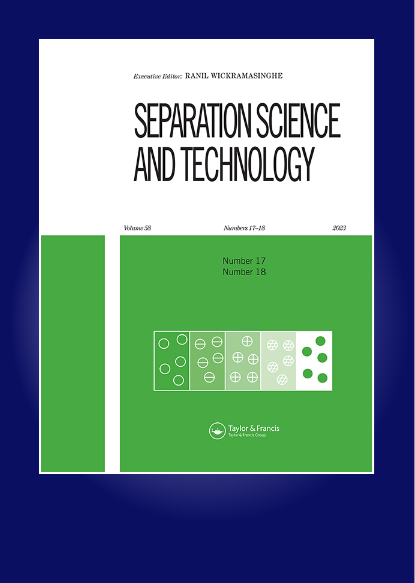Gold recovery from electronic wastes using a solvent extraction/selective back-extraction strategy
IF 2.3
4区 工程技术
Q3 CHEMISTRY, MULTIDISCIPLINARY
引用次数: 0
Abstract
ABSTRACTThe present lab-scale investigation describes a simple and efficient approach to the selective solvent extraction and recovery of gold, and copper as a by-product, from Waste Printed Circuit Boards (WPCBs) of different brands of used computers. The process comprised of three steps; leaching of scraps in aqua regia, solvent extraction process under optimized conditions, and ultimately selective back-extraction. The analysis of leach solution by inductively coupled plasma revealed, in addition to gold (0.14 wt%), copper (40.0 wt%), tin (11.9 wt%), and Ni (2.3 wt%) were the other main metals in the WPCBs. A solvent extraction procedure using trioctylamine, as extractant, dissolved in kerosene was employed for the extraction of gold as its anionic chloride-complexes from the leach liquor. The parameters affecting this process including hydrochloric acid concentration, equilibrium time, extractant concentration, initial gold concentration in the sample solution, and the aqueous/organic volume ratio were optimized by means of the statistical technique response surface methodology (RSM). Under the optimized extraction conditions, 99.6% of gold and 23.4% of copper were transferred into the organic phase, while the extracted percentage of other metal ions were negligible. Selective back-extraction by the solution 0.1 M NaOH resulted in the selective precipitation of copper, while the raffinate contained just gold ions.KEYWORDS: Goldcopperrecyclingsolvent extractionselective back-extractiontrioctylamineresponse surface methodology optimization Disclosure statementThe authors declare no conflict of interest.Statement of NoveltyThe present paper aims to report a new, low-cost, efficient, and simple solvent extraction method, using a solution of trioctylamine dissolved in kerosene, followed by a selective back-extraction procedure method, for efficient recovery of gold from leach liquor of Waste Printed Circuit Boards (WPCBs). The presented method allowed also to obtain metallic copper as the by-product利用溶剂萃取/选择性反萃取策略从电子废弃物中回收黄金
摘要本文研究了一种简单有效的方法,从不同品牌的废旧计算机印刷电路板(wpcb)中选择性溶剂萃取和回收副产物金和铜。这个过程包括三个步骤;废渣在王水中浸出,优化条件下的溶剂萃取工艺,最终选择性反萃取。通过电感耦合等离子体对浸出液的分析发现,除金(0.14 wt%)外,铜(40.0 wt%)、锡(11.9 wt%)和镍(2.3 wt%)是wpcb中的主要金属。采用煤油溶解三辛胺为萃取剂的溶剂萃取法,从浸出液中提取金的阴离子氯化物络合物。采用统计响应面法(RSM)对盐酸浓度、平衡时间、萃取剂浓度、样品溶液中初始金浓度、水有机体积比等参数进行优化。在优化的萃取条件下,99.6%的金和23.4%的铜被转移到有机相中,而其他金属离子的提取率可以忽略不计。0.1 M NaOH溶液选择性反萃取导致铜离子选择性沉淀,而萃液中只含有金离子。关键词:金铜回收溶剂萃取选择性反萃取三辛胺响应面法优化本文报道了一种新的、低成本、高效、简单的溶剂萃取方法,即用三辛胺溶解于煤油中,然后采用选择性反萃取法,从废弃印刷电路板(wpcb)浸出液中高效回收金。所提出的方法还允许获得金属铜作为副产品
本文章由计算机程序翻译,如有差异,请以英文原文为准。
求助全文
约1分钟内获得全文
求助全文
来源期刊

Separation Science and Technology
工程技术-工程:化工
CiteScore
6.10
自引率
3.60%
发文量
131
审稿时长
5.7 months
期刊介绍:
This international journal deals with fundamental and applied aspects of separation processes related to a number of fields. A wide range of topics are covered in the journal including adsorption, membranes, extraction, distillation, absorption, centrifugation, crystallization, precipitation, reactive separations, hybrid processes, continuous separations, carbon capture, flocculation and magnetic separations. The journal focuses on state of the art preparative separations and theoretical contributions to the field of separation science. Applications include environmental, energy, water, and biotechnology. The journal does not publish analytical separation papers unless they contain new fundamental contributions to the field of separation science.
 求助内容:
求助内容: 应助结果提醒方式:
应助结果提醒方式:


